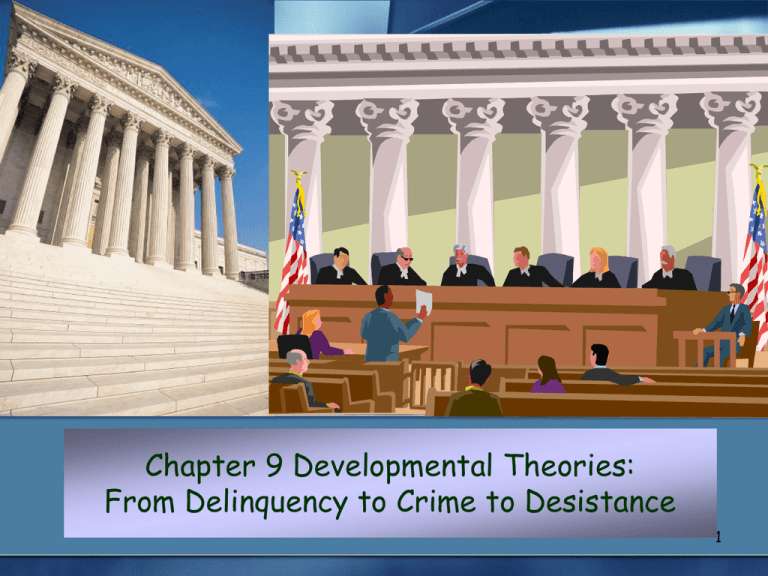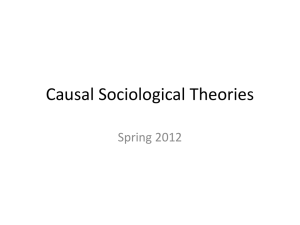Chapter 9 Developmental Theories
advertisement

Chapter 9 Developmental Theories: From Delinquency to Crime to Desistance 1 Chapter Summary Chapter Nine is an overview of the developmental theories. The Chapter begins with an overall discussion of delinquency and the patterns associated with delinquency. The chapter continues with a discussion of ADHD and conduct disorder, and how these disorders are related to delinquency. The Chapter then turns the discussion to the major developmental theories, as well as an evaluation of each of the theories. Chapter Nine concludes with the policy implications that developmental theorists adhere to. 2 Chapter Summary After reading this chapter, students should be able to: Understand the importance of delinquency Identify risk factors for delinquency Understand Agnew’s super traits theory Explain Sampson and Laub’s age grade theory Discuss Farrington’s ICAP theory Discuss Moffitt’s dual pathway theory Evaluate the developmental theories Recognize the policy implications of the developmental theories 3 Introduction Developmental theories are dynamic in that they emphasize that individuals develop along different pathways, and as they develop factors that were previously meaningful to them no longer are, and factors that previously meant little to them suddenly become meaningful. Developmental theorists look at social, psychological, and biological factors simultaneously. 4 Introduction Delinquency: A legal term that distinguishes between youthful offenders and adult offenders that has its origins in the concept of culpability. Except in rare instances, juvenile offenders are not referred to as criminals. Acts that are forbidden by law are called delinquent acts when committed by juveniles. 5 The Extent of Delinquency Juveniles do commit a disproportionate percentage of the UCR’s Part I index crimes. In 2003, youths under 18 accounted for 15.5% of Part I index violent crimes and 28.9% of Part I index property crimes. Delinquent pattern appears at puberty and they slowly burns itself out after reaching its peak between 16 and 18. The age peak in delinquency remains unexplained by any known set of sociological variables. 6 Puberty, Adolescence, and Change Puberty: A developmental stage that marks the onset of the transition from childhood to adulthood. Adolescence is a process that begins at puberty and ends with adulthood. Adolescence is a period of limbo in which individuals no longer need parental care, but are not yet ready to take on the roles and responsibilities of adulthood. 7 Figure 9.1. Illustrating the Age Curve in Different Countries at Different Times From Ellis & Walsh, Criminology: A Global Perspective (2000) p. 109. 8 Figure 9.2. Testosterone Levels of Human Males and Females Across the Lifespan Source: Ellis and Walsh, Criminology: A Global Perspective (2000) 9 Puberty, Adolescence, and Change During adolescence there is an increase in testosterone, changes in the ration of excitatory and inhibitory neurotransmitters, and the physical restructuring of the brain. The earlier the onset of puberty, the greater the level of problem behavior for both boys and girls. Around the age of 20, the transmitters start to decrease and the inhibitory transmitters start to increase. Thus, more adult-like personality traits emerge. 10 Puberty, Adolescence, and Change Terrence Thornberry, David Huizinga, and Rolf Loeber (2004) focus on the escalation of seriousness of delinquent acts being committed as boys age. The overall finding is that as boys get older, their crimes become more serious 11 Figure 9.3 Three Pathways to Boys’ Disruptive Behavior and Delinquency Source: Thornberry, Huizinga, & Loeber, 2004. U.S. Department of Justice: Juvenile Justice 12 Table 9.1 Delinquency Risk Factors by Domain Domain Early Onset (Ages 6–11) Late Onset (Ages 12–14) Protective Factors Individual Being male ADHD/impulsivity Medical, physical problems Aggression Low IQ General offenses Problem (antisocial behavior) Substance abuse Exposure to TV violence Antisocial attitudes, beliefs Dishonestya Restlessness Difficulty concentrating a General offenses Risk taking Aggression a Being male Physical violence Antisocial attitudes, beliefs Crimes against persons Low IQ Substance abuse Intolerant attitude toward deviance High IQ Being female Positive social orientation Perceived sanction for transgressions Family Low socioeconomic status Antisocial parents Poor parent-child relationship Harsh, lax, or inconsistent parenting Broken home Separation from parents Abusive parents Neglect Poor parent-child relationship Low socioeconomic status Harsh, lax, or inconsistent parenting Poor monitoring, supervision Antisocial parents Broken home Abusive parents Family conflict a Warm, supportive relationship with parents and other adults Parent’s positive evaluation of child’s peers Parental monitoring 13 Table 9.1 Delinquency Risk Factors by Domain Domain Early Onset (Ages 6–11) Late Onset (Ages 12–14) Protective Factors School Poor attitude, performance Poor attitude, performance Academic failure Commitment to school Recognition for involvement in conventional activities Peer group Weak social ties Antisocial peers Weak social ties Antisocial, delinquent peers Gang membership Friends who engage in conventional behavior Neighborhood crime, drugs Neighborhood disorganization Stable, organized neighborhood Community Adapted from Office of the Surgeon General, 2001. U.S. Department of Health and Human Services. a. Males only. 14 ADHD & CD Risk factor: Something in individuals’ personal characteristics or their environment that increases the probability of violent offending. It is typical for risk factors to cluster together because the tendency is for miseries to multiply and advantages to aggregate. ADHD: A chronic neurological condition that is behaviorally manifested as constant restlessness, impulsiveness, difficulty with peers, disruptive behavior, short attention span, academic underachievement, risk taking behavior, and extreme boredom. Some children diagnosed with ADHD show EEG patterns of under arousal similar to adult psychopaths. Such a brain wave pattern is experienced subjectively as boredom. 15 ADHD & CD ADHD is related to a wide variety of antisocial behaviors. Conduct disorder (CD): The persistent display of serious antisocial actions that are extreme given the child’s developmental level and have a significant impact on the rights of others. ADHD delinquents are more likely to persist in their offending as adults, but this probability rises dramatically for ADHD children also diagnosed with CD. ADHD does not represent a hopeless pathology that leads its victims down the road to inevitable criminality, particularly when CD is not present. 16 Major Developmental Theories Some theories assume that a latent trait—a “master trait”—influences behavioral choices across times and situations while others do not. 17 Major Developmental Theories All theories maintain that although a criminal career may be initiated at any time, it is almost always begun in childhood. Developmental theories require longitudinal studies. 18 Robert Agnew’s General Theory or “Super Traits” Theory In the super traits theory, Agnew identifies five life domains that contain possible crime-generating factors: Personality Family School 19 Robert Agnew’s General Theory or “Super Traits” Theory Peers Work Agnew identifies the latent traits of low self-control and irritability as “super traits” 20 Robert Agnew’s General Theory or “Super Traits” Theory The neurological and endocrine changes during adolescence temporarily increase irritability/low self-control among adolescents who limit their offending to that period, while for those who continue to offend irritability/low self-control is a stable characteristic. 21 Figure 9.4 Agnew’s General or "Super Traits" Theory PERSONALITY Low Self-Control/Irritability FAMILY Poor parenting, child does not learn selfcontrol or To curb irritability. Poor marriage SCHOOL Negative school experiences, low educational level PEERS Associations with delinquent peers WORK Unemploymen t & poor paying jobs DELINQUENCY & CRIME Note: These five domains interact and feed back on one another. 22 Sampson & Laub’s Age Graded Theory Age-graded theory is essentially a social control theory extended into adulthood to include adult bonds. People who bond well with conventional others build social capital: A store of positive relationships in social networks built on norms of reciprocity and trust developed over time upon which the individual can draw for support. 23 Sampson and Laub’s Age Graded Theory Life is a series of transitions which may change a person’s life trajectory in prosocial directions, which Sampson & Laub call turning points. Age-graded theory strongly emphasizes human agency. 24 David Farrington’s Integrated Cognitive Antisocial Potential (ICAP) Theory The key concepts in ICAP theory are antisocial potential (AP), which is a person’s risk or propensity to engage in crime, and cognition, which is the thinking or decision making process that turns potential into actual process. 25 Figure 9.5 Sampson and Laub’s Age-Graded Developmental Theory Childhood Low SES; low IQ, difficult temperament, family disposition Adolescence Poor bonds to parents and school Serious delinquency Social Capital Lower level of risk factors Good bonds to parents and school Early Adulthood Poor marriage, poor job Late Adulthood Continued offending Gradual desisting from offending Turning Points Minor delinquency Good marriage, good job Desist from offending 26 David Farrington’s Integrated Cognitive Antisocial Potential (ICAP) Theory Individuals with long-term AP tend to come from poor families, to be poorly socialized, low on anxiety, impulsive, sensation seeking, low IQ, and fail in school. Short-term AP individuals suffer any deficits, but may temporarily increase their AP in response to certain situations or inducements. 27 David Farrington’s Integrated Cognitive Antisocial Potential (ICAP) Theory Short-term AP can turn into longterm AP over time as a consequence of offending. Desisting from offending occurs for both social and individual reasons and occurs at different rates according to a person’s level of AP. 28 Terrie Moffitt’s Dual Pathway Developmental Theory The vast majority of youths who offend during adolescence desist and there are a small number of them who continue to offend in adulthood. Life-course persistent offenders are individuals who begin offending prior to puberty and continue well into adulthood. Adolescent limited (AL) offenders have a different developmental history that places them on a prosocial trajectory that is temporarily derailed at adolescence. 29 Life Course Persistent: Applicable to Congenitally Predisposed Youths Temperamental and neuropsychological deficits combine with inept parenting (passive G-E correlation) Antisocial characteristics, negative interaction with others (reactive G-E correlation) Association with delinquent peers (active G-E correlation) Delinquency, crime, and numerous other antisocial behaviors (active G-E correlation) Adolescent-Limited: Applicable to Many "Normal" Youths During Adolescence Early puberty, no real social role, desire for independence. Long wait for adult roles Association with delinquent peers. Antisocial behavior mimicked and reinforced Temporary antisocial characteristics Delinquency. Will desist with neurological and social maturity 30 Terrie Moffitt’s Dual Pathway Developmental Theory Adolescent antisocial behavior is adaptive because it offers opportunities to gain valuable resources they could not otherwise obtain. Association with delinquent peers may be necessary to initiate delinquency for AL offenders, and there is little or no genetic influence on AL delinquency. 31 Desisting For some AL offenders, desistance from antisocial behavior is abrupt, for others it is a slower process. AL offenders desist from offending because they are psychologically healthy and healthy youths respond adaptively to changing contingencies. 32 What about Adolescents who abstain from Delinquency Altogether? Given the personality profiles of abstainers, it is probable that they are individuals located at the hyper tail of the ANS arousal distribution, and thus have excessive guilt feelings and excessive fear of the negative consequences of nonconformity. 33 Evaluation of Developmental Theories Developmental theories offer many advantages because of their dynamic nature. Developmental theories generally integrate and consider sociological, psychological & biological factors as a coherent whole. 34 Evaluation of Developmental Theories They follow the same individuals over long periods of time. They do not rely on convenient samples. The can identify characteristics that lead to onset, persistence, and desistance from crime in the same individuals. 35 Policy and Prevention: Implications of Developmental Theories Developmental theories support the same kind of family-based nurturing strategies supported by biosocial and social- and selfcontrol theories. The Nurse Family Partnership is one program advocated by developmental theorists. Developmental theorists also advocate the Fast Track Project. Developmental theories tell us that human life is characterized by dynamism and people can change at any time. 36





